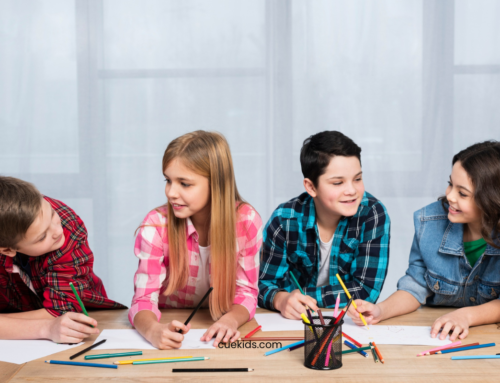Have you ever noticed that you are picking up your children from school and when they meet you they have this big smile and maybe a waving hand? They seemed happy to see or meet you and smiled at you. Or if you are in a public event and your relative calls your children’s name out to meet him or her and the child immediately follows the voice of the speaker and moves their head out of curiosity. We all use such body movements directly or indirectly in our daily conversations. children also imitate these body language cues from us. In this way, non-verbal communication plays a major role in our social activities. It has either a positive or negative impact on children. So, here is why you should teach non-verbal communication to your children.
Non-verbal communication: Why should you teach your children?
- Non-verbal communication, as the name suggests, is a kind of communication we use via our facial expressions, tone of voice, head, hand, and other body language movements to talk with people.
- At a very early age, children interact through their facial features, gestures, and vocalizations to express their emotions. They began to recognize and distinguish faces and can differentiate between smiling, frowning, sad, happy, fearful, and surprised expressions.
- They can learn these gestures by observing, imitating, watching, and mirroring different people in the family.
- Interactions, either verbal or non-verbal cues enhance children’s learning process and help them increase their interest, and improve attention in play and other activities.
- This learning process includes social and situational factors that are essential for developing expressive behavior and concrete parental communication patterns to build up parent-child relations.
Read: Know Yours and Your Child’s Interaction Style
Non-verbal skills: What will kids learn from them?
In the process of language learning, children can learn how to express themselves in a better way. They can acquire self-confidence, energy, perception, and social awareness by expressing themselves through body language. They can learn to recognize their feeling of security to identify and trust the other person. Children can also improve their listening, observing, patience, and also language skills through non-verbal communication. Facial expressions and other body language cues can help them to enhance a feeling of empathy. This will encourage children to create a perspective and a trustworthy bond with parents, friends, and social relations.

Non-verbal expressions children can learn to use in social communication:
- Facial Expressions: These include skin and eye color, wrinkles, muscle tone, maybe hairstyle, or facial hair. Even some facial muscle movements of the forehead, eyebrows, eyelids, cheeks, nose, lips, and chin might help children learn about the individual.
- Eye contact: Children express various emotions, sad, happy, guilty, fearful with their eyes. They can recognize the teacher’s stern look to avoid eye contact or the mother’s worried or empathetic look that she supports them.
- Vocal Intonation: Includes a variety of vocal components such as rhythm, pitch, intensity, nasality, and slurring to express the feelings that are adjusted in stress, tone, and the low or high pace of the parent or teacher’s voice.
- Touching: This represents a caring or affectionate response to children, for example: a teacher might give a pat on the back to a child for doing well on his homework.
- Body gestures and movements: Convey the meanings of emotions through body language cues. These body gestures move in harmony with the verbal context. for ex: a student slouching may send a message of less interest or enthusiasm toward a particular topic.
- Use of space: This comprises identifying the personal, physical, and spatial distance between children and others. These distances and arrangements should be appropriate for children’s interaction in classrooms and social situations depending on the conversational topic, the nature of the relationship, and physical restrictions.
Read: Developing Social Skills in Children
5 activities kids can learn to build Nonverbal skills:
Body language Charades:
In this game, children can act out and others can interpret non-verbal signs such as smiling, frowning, nodding, yawing, resting chin in both hands or on knuckles, and glancing around the room. These cues will help them to identify others.
Mimes:
It can be a parent-child activity in that one has to enact the emotion or situation from a slip of paper in front of everyone using only his or her body language, and others will try to interpret those emotions.
Picture Books:
A parent can make a child read a picture book with his friend and ask them to pay attention to the character’s body gestures to express their thoughts and ideas.
Simon Says:
Children can play the ‘Simon says’ game as usual but here, they can use non-verbal cues instead of words for instructions. A teacher can build a series of non-verbal cues in this activity. For example: look happy: jump for joy, look excited: and clap your hands.
Mirror game:
Here, a child has to pretend that he is a mirror and his friend has to copy all the actions that he does while playing the game. Ask children to take turns so everyone will initiate and copy each other.
Conclusion
Teaching non-verbal skills are essential for children’s educational and social development. Teachers and parents must help children understand these skills. They can encourage kids to learn from public speaking and people skills courses. They can learn social communication and build their confidence and interpersonal skills in social interactions.
References:
Haneef Muhammad, The Role of Non-verbal Communication in Teaching Practice, 2014, Lahore, http://www.sci-int.com/
Miller, Patrick, Non-verbal Communication, Third Edition, What Research says to the Teachers, National Education Association, Washington D.C. 1988,
https://files.eric.ed.gov/fulltext/ED293190
Web source:






[…] You may also like to read: How can Body Language help children build Confidence? […]